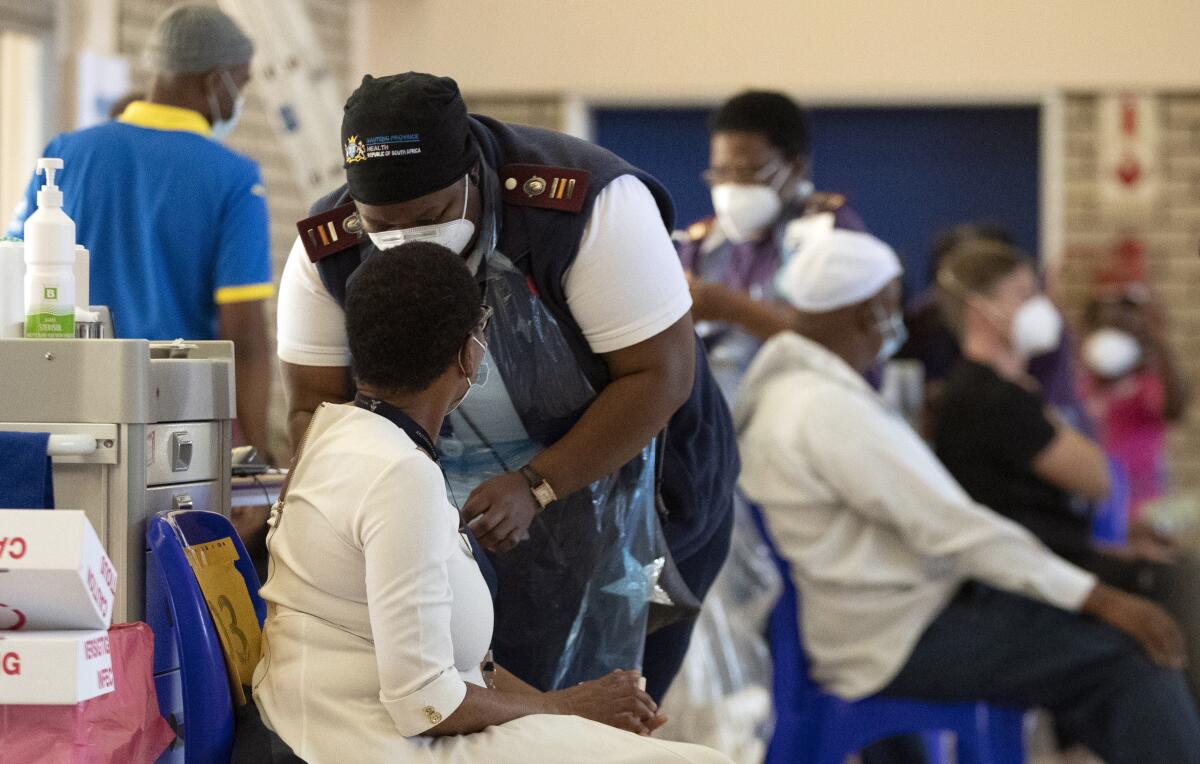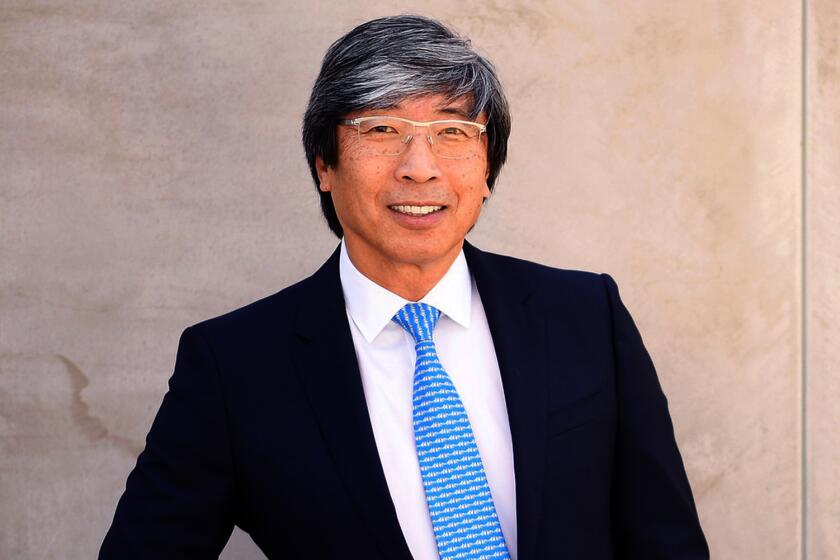Most of the world has no COVID-19 vaccine. That’s a huge global threat

- Share via
An emerging reality of the COVID-19 pandemic is that most of the global population, including almost everyone living in the world’s low- and middle-income countries (LMICs), lacks access to COVID-19 vaccines. A public health and global security crisis is unfolding as new variants of concern accelerate in Africa, Latin America and the poorest nations of Asia. The cases and deaths will soon increase.
Ultimately, this situation represents a failure to create a system in which new vaccines for pandemic threats could be developed and produced locally, and designed specifically for use in resource-depleted health systems. The fact that no new vaccines are made in Africa (or in many other low- and middle-income countries) reflects profound lapses in international science cooperation and diplomacy between wealthy and poor nations. This will soon have catastrophic consequences.
Here is the current status: Only a minuscule number of people have been vaccinated against COVID-19 in sub-Saharan Africa, in some of the largest Southeast Asian countries, including Pakistan and the Philippines, and in many Latin American countries. So far, Africa is being vaccinated at around 1/50th the vaccination rate of North America, and that ratio is even lower if Morocco (where 5 million doses have been administered) were not included. South Africa has administered fewer than 140,000 doses so far. In contrast, more than 24 million doses have been given in Britain, which is not much larger in population.
There are doubts that this situation might change anytime soon — our ability to scale up production of the two mRNA vaccines (from Moderna and Pfizer-BioNTech) or deliver them through complicated freezer chain requirements means that they might not find widespread use in LMICs. So far, no African country, except Rwanda, has received any doses of mRNA vaccines. South Africa is the only African nation to receive the new Johnson & Johnson vaccine, and this is happening through a research study involving up to 500,000 healthcare workers in that country; four other nations are getting the AstraZeneca-Oxford vaccine.
Second Opinion is a forum for big ideas on global challenges. This opinion and video series will feature solutions-oriented ideas and arguments on topics critical to humanity’s future.
Sub-Saharan Africa in particular faces an imminent and potentially catastrophic loss of life from COVID-19. While African countries have done reasonably well (100,000 reported deaths in Africa) compared with the United States (530,000 deaths), Europe (850,000 deaths) or Brazil (270,000 deaths), the emerging B.1.351 variant from South Africa may soon change this situation. COVID-19 is already accelerating in nearby southern Africa countries such as Malawi and Zimbabwe. The Institute of Health Metrics and Evaluation projects that the number of people who will lose their lives in sub-Saharan Africa from COVID-19 will more than double from Jan. 1 to May 1, with numbers expected to climb from there. Tragically, we do not have many vaccine options.
The AstraZeneca-Oxford vaccine offers very low protection against the B.1.351 variant, and it is not clear whether vaccines from Russia and China will be effective. Other vaccines in development from manufacturers in India might have a role.
The global policymakers anticipated this situation and did their best to try to protect sub-Saharan Africa and low- and middle-income countries in Latin America and Asia, and ensure that they could receive their fair share of vaccines from the big pharma companies. They created a COVAX facility to maximize equity and distribution for the world’s poor. Ghana and Ivory Coast recently became the first countries to receive vaccine through COVAX.
However, the real numbers of vaccine doses required are daunting. With a population of approximately 1.1 billion people in sub-Saharan Africa, we would need to immunize approximately 800 million people to interrupt virus transmission. Many of the vaccines require two doses, and possibly a third as a booster down the line. It is not unreasonable to believe that we may need 2 billion doses of vaccine for Africa.
The current model for developing and providing vaccines against pandemics threatening low- and middle-income countries in Africa and elsewhere does not work. COVID-19 reminds us yet again that these areas of the world rely too heavily on multinational pharmaceutical companies and midsize biotech firms for vaccines.
In fairness, the pharmaceutical industry’s commitment to the world’s LMICs is important and certainly not negligible. For example, Gavi, the Vaccine Alliance, depends heavily on the big vaccine producers, and in 2019, Merck & Co. delivered lifesaving Ebola vaccines to the Democratic Republic of the Congo that helped to stabilize the situation in Africa. COVAX in collaboration with the industry is working day and night to support Africa and Latin America.
But the lack of durable, easy-to-scale and effective COVID-19 vaccines reminds us of the urgency to shape a new or parallel framework. A long-term solution is to build or expand vaccine development capacity in Africa, the Middle East, Latin America and other regions with low- and middle-income countries.
Consider Africa: State-of-the-art vaccine research and production facilities on the African continent would be game changing for multiple reasons. First, it would provide urgently needed vaccines that are specific for the region, including potential variants of concern for specific viral pathogens. This includes capacity for producing mRNA vaccines, a technology that in time will be refined to become easier to scale and stabilize at normal refrigerator temperatures or even room temperatures. Vaccines could be developed for Africa’s diseases of regional importance, including neglected tropical diseases such as Buruli ulcer, sleeping sickness or schistosomiasis, which are unlikely to attract the interest of pharmaceutical companies in North America and Europe.
A vaccine facility for Africa could also become a stimulus to train African scientists. The largest hurdle for establishing a center for excellence is not so much the investment in the physical facilities, but rather the human capital — trained vaccine scientists and staff versed in scaling up production, quality control and quality assurance.
When I served as U.S. science envoy in the Middle East and North Africa, I came to realize building vaccine development capacity requires unprecedented international cooperation. African scientists and staff will need to be trained in vaccine development and production facilities in the U.S., Europe, India and possibly elsewhere. In addition to academic and government labs, it may be necessary to provide access to the facilities of major pharma companies. The process around approving and monitoring vaccine will require partnerships between a group of World Health Organization-designated “stringent” regulatory authorities in the U.S., Europe and Japan and selected national regulatory authorities in Africa.
There are no quick fixes in this endeavor. Realistically, establishing a lead vaccine facility could become a decade-long project. In this context, at least one public-private initiative has already begun in South Africa, but we will need others located in low- and middle-income countries in Africa and elsewhere.
These steps are necessary to slow the future pandemics that will surely emerge. We had SARS in 2003, H1N1 influenza in 2009, MERS in 2012, Ebola in 2014, Zika in 2016, and now COVID-19. There is more to come.
Peter Hotez served as U.S. science envoy for the Middle East and North Africa in the Obama administration. He is a professor of pediatrics and molecular virology and microbiology at Baylor College of Medicine, where he is also co-director of the Texas Children’s Center for Vaccine Development and dean of the National School of Tropical Medicine. He is the author of “Preventing the Next Pandemic: Vaccine Diplomacy in a Time of Anti-Science.”
More to Read
A cure for the common opinion
Get thought-provoking perspectives with our weekly newsletter.
You may occasionally receive promotional content from the Los Angeles Times.










